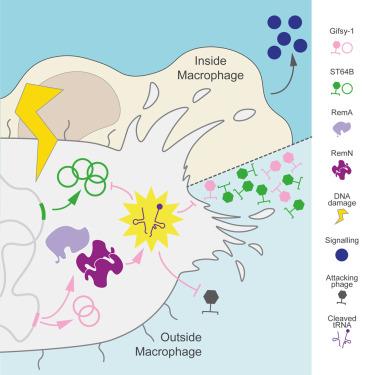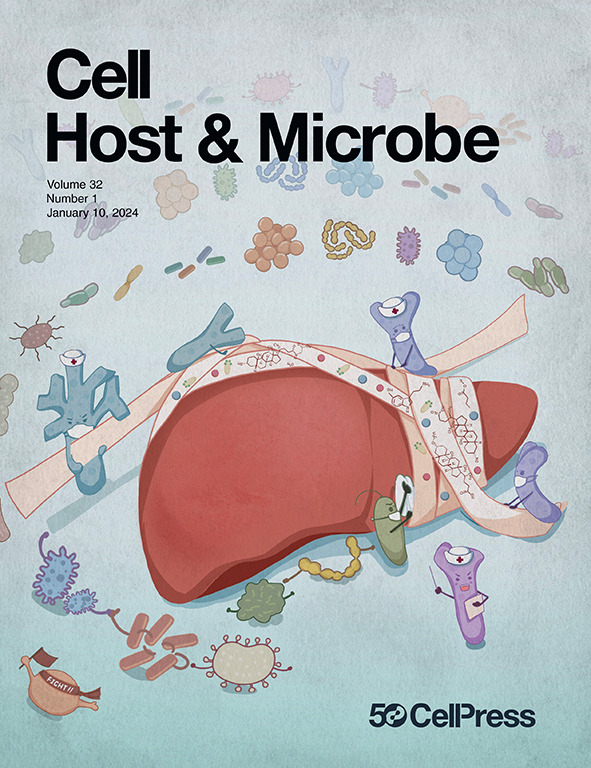A prophage competition element protects Salmonella from lysis
IF 20.6
1区 医学
Q1 MICROBIOLOGY
引用次数: 0
Abstract
Most bacteria are polylysogens that carry multiple prophages integrated into the chromosome. These prophages confer advantages to their bacterial host, yet also pose a lethal threat as they can reactivate and enter a lytic cycle. DNA damage of the bacterial host is a common trigger of prophage lytic cycles. Because DNA damage is frequently experienced by bacterial pathogens exposed to host immune defenses, prophage activation may be common during infection. Investigating the consequences of prophage induction in Salmonella, we discover a prophage competition element in the Gifsy-1 prophage that we name ribonuclease effector module with ATPase, inhibitor, and nuclease (RemAIN) because it blocks the lytic cycles and release of viral particles of co-resident prophages. Intramacrophage Salmonella persisters, a subpopulation that incurs DNA damage, experience prophage reactivation and subsequent RemAIN activation, which influences Salmonella persisters and macrophage response to infection. Our findings reveal a multi-layered host-pathogen arms race in which prophage-prophage competition influences bacterial persistence and the mammalian immune response.

噬菌体竞争元件保护沙门氏菌不被溶解
大多数细菌都是多聚原生体,其染色体上集成有多个噬菌体。这些噬菌体给细菌宿主带来优势,但也构成致命威胁,因为它们可以重新激活并进入溶菌循环。细菌宿主的 DNA 受损是噬菌体溶菌循环的常见触发因素。由于细菌病原体经常受到宿主免疫防御系统的 DNA 损伤,因此噬菌体在感染过程中可能会被激活。在研究沙门氏菌噬菌体诱导的后果时,我们在 Gifsy-1 噬菌体中发现了一种噬菌体竞争元件,我们将其命名为具有 ATP 酶、抑制剂和核酸酶的核糖核酸酶效应模块(REMAIN),因为它能阻止共驻噬菌体的溶解循环和病毒颗粒的释放。巨噬细胞内的沙门氏菌宿主是造成 DNA 损伤的亚群,它们会经历噬菌体再激活和随后的 RemAIN 激活,这影响了沙门氏菌宿主和巨噬细胞对感染的反应。我们的研究结果揭示了宿主与病原体之间的多层次军备竞赛,其中噬菌体与巨噬细胞之间的竞争影响了细菌的持久性和哺乳动物的免疫反应。
本文章由计算机程序翻译,如有差异,请以英文原文为准。
求助全文
约1分钟内获得全文
求助全文
来源期刊

Cell host & microbe
生物-微生物学
CiteScore
45.10
自引率
1.70%
发文量
201
审稿时长
4-8 weeks
期刊介绍:
Cell Host & Microbe is a scientific journal that was launched in March 2007. The journal aims to provide a platform for scientists to exchange ideas and concepts related to the study of microbes and their interaction with host organisms at a molecular, cellular, and immune level. It publishes novel findings on a wide range of microorganisms including bacteria, fungi, parasites, and viruses. The journal focuses on the interface between the microbe and its host, whether the host is a vertebrate, invertebrate, or plant, and whether the microbe is pathogenic, non-pathogenic, or commensal. The integrated study of microbes and their interactions with each other, their host, and the cellular environment they inhabit is a unifying theme of the journal. The published work in Cell Host & Microbe is expected to be of exceptional significance within its field and also of interest to researchers in other areas. In addition to primary research articles, the journal features expert analysis, commentary, and reviews on current topics of interest in the field.
 求助内容:
求助内容: 应助结果提醒方式:
应助结果提醒方式:


